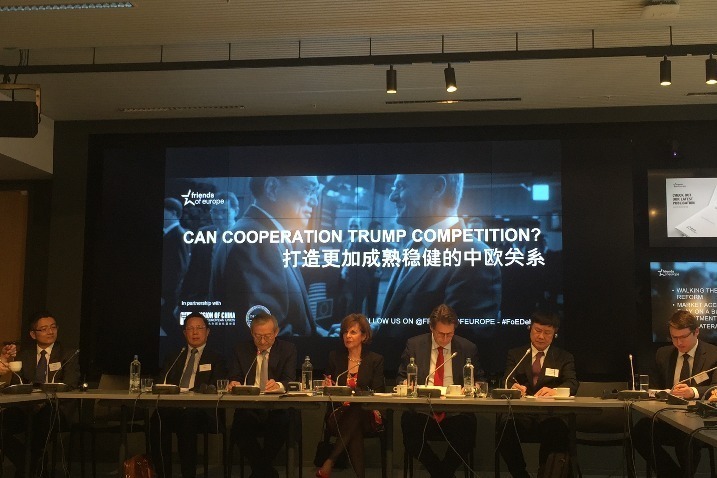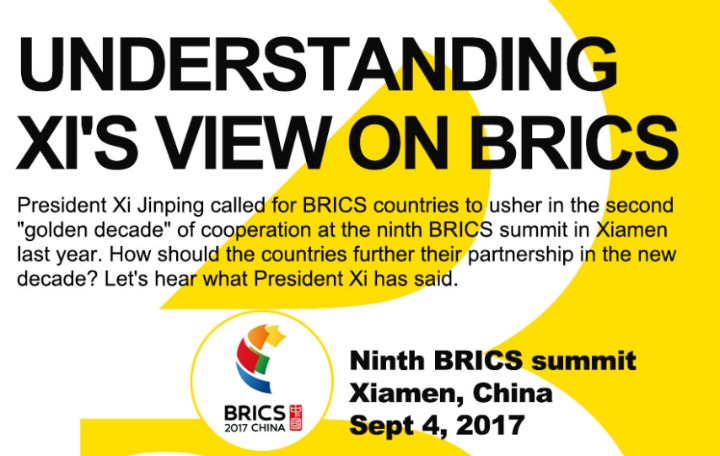China, EU need cohesion against trade challenges
By Kerry Brown |
Updated: 2018-07-04 17:09
Editor's Note: This article is part of Preview Policy Report for the 2018 China-EU Summit, which will be jointly published by China Watch Institute — the new think tank platform powered by China Daily — and Bruges-based EU-China Research Centre of the College of Europe.
There was a time in the earlier part of this decade when the possibility of a global trio of the US, China and the EU looked like it might be the ultimate geopolitical club – a G3, as it were. Even at the height of this speculation, however, there were issues over misalignments and imbalances between the three potential partners. While the US and China seemed to be more alike because they were sovereign nations, and the EU a gathering of 28 countries, it was always as though China was perpetually facing two parties that were so close in interests they might have been one. The US and the EU were close diplomatic partners, able to find plenty of common ground on seeking greater market access and trade facilitation with China. They often worked in concert, even if they were sometimes competitors to the commercial opportunities that China offered. On security, too, the EU and the US largely spoke form the same script. Their main difference was one of capacity. The EU was called a soft superpower, not a hard power player. In the Asian region, it was the US navy that played the biggest role, with the EU giving moral support and little else.
Under the maverick leadership of US President Donald Trump, that balance has been tipped upside down. The usual contours of international trade relations and commitment to the agreements underpinning them have been questioned, and in some places even looks like they are close to being jettisoned. Trump announced large tariffs against a raft of Chinese goods in June. But at the same time, he also threatened similar moves against the EU. In one swift movement, the EU and China were brought closer together in a wholly unexpected way. It is hard to believe, but they are now allies against a US which once led the world in liberal free trade support, but is now becoming more protectionist and unreliable by the day.
China and the EU will have the opportunity to work out the implications of these changes at their 20th annual high level summit in July. There are some areas where the EU might be supportive of US pressure on China. Like with the US, the EU collectively runs a large trade deficit with China. Like the US, it wants improved market access. And it is also undergoing a difficult internal discussion about where, and how best, to engage with Chinese outward investment.
What is hard to factor in all of this is that despite the common ground, officials at the highest level in the EU have been as taken aback as anyone else by the ferocity of the Trump onslaught on a partner that was once an unquestioned ally. Things are only likely to get more tense when Trump attends the NATO summit in July. There, he is expected to continue his complaints about how the US can no longer foot the security bill for other countries and needs more of a contribution.
While the EU and China can personalize what is happening at the moment and attribute it all to Trump, the underlying causes of the current turbulence are easy to set out: the US is running unsustainable levels of debt. It cannot continue to accrue such vast debts, and the Trump surge is an attempt to address this. Because of the importance of the US economy to the rest of the world, the EU and China need to work out a way of addressing the current issues. They now have a joint cause which, while difficult and unexpected, might ironically bring them closer than ever before.
First, the EU and China are now the most important supporters of free trade. They need to work out how they can support the current global system of rules and norms which the US seems to be out to undermine and destabilise. Brussels and Beijing have a vested interest in ensuring that damage is minimized, and that a constructive, viable response is given to the questions Washington is raising. There needs to be consideration of further liberalization of the Chinese economy for outside investors and partners. Trump has threatened to withdraw from the World Trade Organization. Pre-emptive responses to this need to be considered. The Europeans and Chinese will need to have a deeper strategic discussion than ever before.
While the Chinese have already had to think urgently about how to mitigate the impact of US tariffs and deal with a potential escalation toward a trade war between the world’s two largest economies, the EU remains distracted by its own internal issues. There is a real risk that these will consume its energy and mean that a major moment which, while full of challenges, also shows real potential to make the EU more cohesive and meaningful than ever before, will pass by. Brexit is one of a raft of issues, though probably less important than the other – the skepticism of populist governments in Italy toward deeper EU financial integration, and the ongoing turmoil in Germany and other places over immigration and the best political and social response.
Europe has never had such a fragmented leadership in recent times. Only Emmanuel Macron of France looks relatively secure, and even he is faced with immense problems of domestic reform. Germany’s Angela Merkel has been greatly weakened by a poor election result last year, and ongoing criticism of her stance on migration this year. The UK is due to leave the EU in March 2019, but its posture becomes increasingly diluted as it becomes clear that a complete break from the EU market would be economic suicide. With all these issues, trying to think of a longer term response to the US trade moves and some new framework of how to work with China seem a low priority item.
This is a mistake. The EU is now in a position where it can legitimately demonstrate some coherence against a US president who is posing questions and creating issues as never before, and demanding new ideas from those who were originally its closest allies. Europe has lived since World War II within a world where the US was unquestioned and a stable, constant part of its world view. It is clear that that world is now changing. As never before, the EU has to start thinking of what a more standalone economic and geopolitical identity might be. This is something it is no doubt unwilling to do, and did not ever want to do. But like it or not, this is what is happening as Trump’s America moves increasingly into a protectionist, isolationist mode. Discussions with China are where this new EU autonomy will come to the fore quickest. At the China-EU summit, we will either see the emergence of this, or desire to maintain a status quo which is no longer there to defend. That is the stark choice facing EU leaders when they meet their Chinese counterparts in July.
Kerry Brown is a professor of Chinese studies and director of the Lau China Institute at King's College. The author contributed this article to China Watch exclusively. The views expressed do not necessarily reflect those of China Watch.
All rights reserved. Copying or sharing of any content for other than personal use is prohibited without prior written permission.
Editor's Note: This article is part of Preview Policy Report for the 2018 China-EU Summit, which will be jointly published by China Watch Institute — the new think tank platform powered by China Daily — and Bruges-based EU-China Research Centre of the College of Europe.
There was a time in the earlier part of this decade when the possibility of a global trio of the US, China and the EU looked like it might be the ultimate geopolitical club – a G3, as it were. Even at the height of this speculation, however, there were issues over misalignments and imbalances between the three potential partners. While the US and China seemed to be more alike because they were sovereign nations, and the EU a gathering of 28 countries, it was always as though China was perpetually facing two parties that were so close in interests they might have been one. The US and the EU were close diplomatic partners, able to find plenty of common ground on seeking greater market access and trade facilitation with China. They often worked in concert, even if they were sometimes competitors to the commercial opportunities that China offered. On security, too, the EU and the US largely spoke form the same script. Their main difference was one of capacity. The EU was called a soft superpower, not a hard power player. In the Asian region, it was the US navy that played the biggest role, with the EU giving moral support and little else.
Under the maverick leadership of US President Donald Trump, that balance has been tipped upside down. The usual contours of international trade relations and commitment to the agreements underpinning them have been questioned, and in some places even looks like they are close to being jettisoned. Trump announced large tariffs against a raft of Chinese goods in June. But at the same time, he also threatened similar moves against the EU. In one swift movement, the EU and China were brought closer together in a wholly unexpected way. It is hard to believe, but they are now allies against a US which once led the world in liberal free trade support, but is now becoming more protectionist and unreliable by the day.
China and the EU will have the opportunity to work out the implications of these changes at their 20th annual high level summit in July. There are some areas where the EU might be supportive of US pressure on China. Like with the US, the EU collectively runs a large trade deficit with China. Like the US, it wants improved market access. And it is also undergoing a difficult internal discussion about where, and how best, to engage with Chinese outward investment.
What is hard to factor in all of this is that despite the common ground, officials at the highest level in the EU have been as taken aback as anyone else by the ferocity of the Trump onslaught on a partner that was once an unquestioned ally. Things are only likely to get more tense when Trump attends the NATO summit in July. There, he is expected to continue his complaints about how the US can no longer foot the security bill for other countries and needs more of a contribution.
While the EU and China can personalize what is happening at the moment and attribute it all to Trump, the underlying causes of the current turbulence are easy to set out: the US is running unsustainable levels of debt. It cannot continue to accrue such vast debts, and the Trump surge is an attempt to address this. Because of the importance of the US economy to the rest of the world, the EU and China need to work out a way of addressing the current issues. They now have a joint cause which, while difficult and unexpected, might ironically bring them closer than ever before.
First, the EU and China are now the most important supporters of free trade. They need to work out how they can support the current global system of rules and norms which the US seems to be out to undermine and destabilise. Brussels and Beijing have a vested interest in ensuring that damage is minimized, and that a constructive, viable response is given to the questions Washington is raising. There needs to be consideration of further liberalization of the Chinese economy for outside investors and partners. Trump has threatened to withdraw from the World Trade Organization. Pre-emptive responses to this need to be considered. The Europeans and Chinese will need to have a deeper strategic discussion than ever before.
While the Chinese have already had to think urgently about how to mitigate the impact of US tariffs and deal with a potential escalation toward a trade war between the world’s two largest economies, the EU remains distracted by its own internal issues. There is a real risk that these will consume its energy and mean that a major moment which, while full of challenges, also shows real potential to make the EU more cohesive and meaningful than ever before, will pass by. Brexit is one of a raft of issues, though probably less important than the other – the skepticism of populist governments in Italy toward deeper EU financial integration, and the ongoing turmoil in Germany and other places over immigration and the best political and social response.
Europe has never had such a fragmented leadership in recent times. Only Emmanuel Macron of France looks relatively secure, and even he is faced with immense problems of domestic reform. Germany’s Angela Merkel has been greatly weakened by a poor election result last year, and ongoing criticism of her stance on migration this year. The UK is due to leave the EU in March 2019, but its posture becomes increasingly diluted as it becomes clear that a complete break from the EU market would be economic suicide. With all these issues, trying to think of a longer term response to the US trade moves and some new framework of how to work with China seem a low priority item.
This is a mistake. The EU is now in a position where it can legitimately demonstrate some coherence against a US president who is posing questions and creating issues as never before, and demanding new ideas from those who were originally its closest allies. Europe has lived since World War II within a world where the US was unquestioned and a stable, constant part of its world view. It is clear that that world is now changing. As never before, the EU has to start thinking of what a more standalone economic and geopolitical identity might be. This is something it is no doubt unwilling to do, and did not ever want to do. But like it or not, this is what is happening as Trump’s America moves increasingly into a protectionist, isolationist mode. Discussions with China are where this new EU autonomy will come to the fore quickest. At the China-EU summit, we will either see the emergence of this, or desire to maintain a status quo which is no longer there to defend. That is the stark choice facing EU leaders when they meet their Chinese counterparts in July.
Kerry Brown is a professor of Chinese studies and director of the Lau China Institute at King's College. The author contributed this article to China Watch exclusively. The views expressed do not necessarily reflect those of China Watch.
All rights reserved. Copying or sharing of any content for other than personal use is prohibited without prior written permission.









